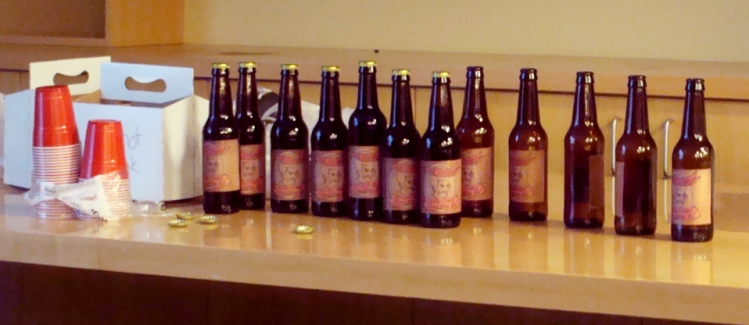In preparation of our Food issue (submissions open until November 1, after which they’ll simmer ’til winter), I’ve asked members of the LPR community to share stories of what they eat. Food occupies such a central place in our lives, that we can’t help but grow with it. Whether we were pushing ourselves to do more than just survive or, as is the case with my entry, trying to feel at home while driving away roommates with the smell of boiling malt and hops, we can call on the sounds, smells, and tastes of our most formative and transformative foods to walk back into our own narrative histories. And on Laura’s suggestion, each piece in this series will feature a recipe, so you can cook yourself through an experience yourself. If you have a transformative experience with food, leave a comment and I’ll be in touch.
And now that I’ve laid the table, well, me:
“They’re good, but I don’t think they have enough flavor for brewing.” Martin picked a wild plum off of a tree growing alongside the trail and handed it to me. I popped one in my mouth and picked another before following Martin around a bend to look over the marshes and coastline. He handed me the binoculars and pointed to a spit of beach, “Over there, by the boat.” I lifted the binoculars, and surrounded by samphire, sea purslane, godwits, and gulls, I watched the tourists snap photos of seals while their boat paced the coast.

The Blakeney salt marsh. (Photo: Gerry Balding)
A year and a half before, I was clutching a rag against my bloody thumb while dumping wort into a carboy in my small kitchen in Brooklyn. I was bleeding onto the airlock, scrambling to find my sanitizing solution, and finding all my clever preparations for this moment failing. I was brewing my first beer—an English brown ale. But after six months of drawing maps in my notebook, learning the best places to buy groceries, and finding a good slice within walking distance of my door, I would still hesitate to call myself a homebrewer.

Martin Warren in the smokehouse of JWH Jonas Fishmongers, a business now nearly two centuries old. (Photo: Steve Adams)
I first met Martin while cycling the length of the Norfolk coast in England. He opened the doors of his Poppyland Brewery for me on a Sunday morning, and I stepped into the biscuit-sweet smell of malt. As we talked shop and shared ideas, we sampled his Stewkey Gose, named (phonetically) for the Stiffkey River which feeds the marshes. The aroma coming off of the hazy pale beer told me how much I’d missed in the miles between the train station in King’s Lynn and this tiny brewhouse in Cromer. Martin had been in the marsh, foraging fistfuls of plants that call this unique ecology home. He told me that he wanted to transport his drinker here, and to celebrate this place. In its delicate balance of sour and salt, herb and earth, I found one of the most interesting and thought-provoking beers on the island.
But the gose isn’t alone in Martin’s range. He brews with barley grown just two dozen miles away from the brewhouse door. He has taken that malt and his hops to a local smokehouse, giving his smoked porter a distinctive tobacco character I haven’t found anywhere else. He brews a saison to be paired with Cromer crab. On this recent visit, we walked into a candy shop and ordered a slice of fudge to split while walking about town. “This is where my gluten-free brewing all began,” Martin said, indicating the clerk behind the counter. “Digby’s got coeliac, and I wanted him to try my beer. There are so few gluten-free beers out there, but it’s so easy to do.” Martin uses an enzyme to degrade one of the two proteins implicated in coeliac disease (the other is naturally degraded during brewing by enzymes present in the barley). When Martin held out some bills for the fudge, Digby shook his head and pushed the fudge over the counter to us.
Homebrewing simply refers to brewing within the confines of one’s residence. I still brew in my kitchen. Two years ago, Martin moved his operation into an automotive garage (opened just two decades after the birth of the automobile) across the street from his house. But Martin is much more a homebrewer than I am. As a retired curator of the Cromer Museum and leader of geology walks, brewing is one more manifestation of Martin’s sense of home.
Most of my life, I’ve felt out of place. I didn’t grow up fishing, sailing, or pitching crab traps full of chicken necks off a pier. My first time at a tryout for lacrosse saw me flat in the mud as more experienced players trounced me. I hardly saw Baltimore beyond the commercial island of the Inner Harbor. Whether or not these experiences would’ve made me a Marylander, hearing my peers’ chatter put me on the outside. When my travels took me to suburbs of Chicago or Long Island, my disorientation was only exacerbated by finding the same houses—homes to others. I don’t know my geography.
But while cycling through farms and woodland bridleways with Martin, learning how he’s shaping his geography through guerrilla gardening and rerouting trails, I had hopeful thoughts that maybe I’ve succeeded in sowing some seeds in Brooklyn. Just a few blocks from my apartment, a homebrew shop hosts a community pulled together from all reaches of the city. We’re all fascinated by fermentation. I am hopeful that these seeds take root, and by spring be budding. Martin is planning a visit, and I’d like to be able to show him the home I’ve been brewing.

Bottles of my first brew. I served samples while giving a talk on homebrewing
as part of an informal graduate student lecture series at NYU.
English Brown Ale
This is a version of the first beer I ever brewed, with some modifications that I think simplify and improve the recipe.
- 1 satchet Fermentis SafAle S-04 dry English yeast
- 2 oz East Kent Goldings hops
- 8 oz 120L caramel malt
- 4 oz 40L caramel malt
- 4 oz chocolate malt
- 6 oz Victory malt
- 5.5 lbs light dry malt extract
- 3+ gallon pot with lid
- 6 gallon food-grade plastic bucket with lid
- Sanitizing solution (StarSan or 1 tbsp bleach in 2 gallons water or 12.5 ppm iodine solution)
- Place your crushed grains into a muslin bag (the shop where you bought the grains should crush them for you). Fill your largest pot (hopefully 3+ gallons, from now on called your brew kettle) with water, leaving at least a half gallon headspace. Bring to about 170 F, cut heat, and submerge grains. Let steep for 10–15 minutes, agitating to make sure all the grain is wet. The water will turn dark.
- Remove the grain bag and set into a colander above another pot to collect any goodness dripping out of the grains. You can squeeze the grain bag if you dare (the grains are hot!). Bring the brew kettle to a boil, uncovered. Once the grain bag stops dripping, you can dispose of it and add the collected wort (jargon for unfermented beer) to the brew kettle.
- Once the wort is boiling, dissolve your dry malt extract into the wort. Be careful, as it will foam, and boil-over is possible. If the foam is getting out of control, cut the heat. Also, once the malt extract is exposed to humidity, it starts to clump and stick, which can make handling it more difficult. Dissolving it all may take 10 minutes or more depending on the intensity of your boil and the amount of headspace in your kettle. If you feel you don’t have enough headspace, just let the wort boil off some water until you’re comfortable with the volume.
- Add one ounce of hops, and set a timer for 45 minutes. Hops add bitterness, and the longer you boil them, the more bitterness is extracted. Therefore, it is important that if you want to reduce the volume of the wort in your kettle, you should allow it to boil off before adding hops.
- After 35 minutes has passed (i.e., 10 minutes on left on the timer), add another ounce of hops. You may want to begin preparing an ice water bath in a sink or tub.
- After 45 minutes, when your timer goes off, turn off the heat. Move the brew kettle to the water bath. Once the temperature of the wort drops below 180 F, cover with lid. Let it sit, replacing the water and/or ice in the bath when it warms, until the wort reaches room temperature.
- Sanitize your food-grade plastic bucket by making sure your sanitizing solution contacts all surfaces that the wort will touch. A spray bottle helps. If using bleach solution, make sure to rinse with boiled (and cooled—don’t melt your bucket) water. Other sanitizers needn’t be rinsed. Pour contents of brew kettle into your food-grade plastic bucket.
- Open satchet of yeast and add to wort. Legally, your wort is now beer. Cover bucket loosely with lid. Fermentation produces a lot of gas, so you’ll either need an airlock to allow gas to escape or you’ll need to leave the seal of the lid loose. Move the bucket to a cool (~60–65 F) place if you have one. Anywhere around 70 F is okay.
- Anytime you’re feeling curious, lift the lid and sneak a peak. But not too often! You were so careful to kill bacteria and yeast that were in the bucket before you started, don’t go letting them in now. After two or three weeks, your beer is probably done fermenting, and you should go over to How To Brew to learn about bottling. And you should learn more about brewing and do it all over again, but even better.


clarinda harriss
I have new respect for beer and especially its home brewers! Your piece is so rich in detail (as well as some of the arcane language of brewing) that I actually smell the brew, well, brewing. And it is delicious, kind of breadlike. . . . I love the double meaning of “home” at the very end. Sure, shorthand for home brew. But also your having found a place you belong. Kudos!
LikeLike
Dylan Bargteil
I’m glad you enjoyed the imagining the bready smell of brewing. To me it’s a very special smell, but many find it repugnant! I think brewing, and many other old world culinary arts (cheese making, baking, etc.), have such a rich language around them. Barm, bung, wort, and must!
LikeLike
Pingback: What You Eat: Home Brewing | Little Patuxent Review | Know What You Eat
Laura Shovan
Gluten-free beer? Send some my way when you try making a batch, Dylan. The instructions to this recipe remind me of experimenting in the chemistry classroom, but with much more delicious results.
LikeLike